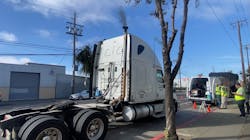How to prep for California's Clean Truck Check program
The commercial vehicle industry has known that California will enforce tighter emissions regulations for years, and the time for fleets to act is dwindling. The state’s Clean Truck Check program, which was enacted to ensure commercial vehicles' emissions control systems operate as designed and are quickly repaired when not, was approved by the California Air Resources Board (CARB) in December 2021.
"Essentially, the California Air Resource Board is enacting a new emissions regulation that's requiring all non-gasoline heavy-duty vehicles with a Class 4 gross weight rating of 14,000 lbs. or higher to pass an emissions inspection in order to operate in California," explained Bill Hathaway, chief product officer for Noregon, a provider of heavy-duty diagnostic tools and software. He spoke about the Clean Truck Check program on a recent Fleet Maintenance webinar. (Noregon also has an in-depth overview of the program HERE.)
It's set to go into effect at the end of the year, and in preparation, this October, CARB launched the website where truck operators can register their vehicles in the database and pay the $30 compliance fee.
Hathaway emphasized that any truck meeting those criteria that operate in California is subject to the rule, even if registered out of state. Inspections begin July 2024. To remain compliant, fleets outside of California that plan to travel in the state on or after July 2024 will need to register and pay the $30 fee. At the onset, CARB will require these trucks to receive two inspections per year.
For vehicles with 2013 model year (MY) engines and newer, these inspections can be done with a certified diagnostic scan, while engines older than 2013 will require visual inspections. Both types of examination must occur twice per year, with the frequency for 2013 or newer vehicles increasing to four times per year in 2026.
CARB got an early jump on enforcement at the start of 2023, deploying screeners to search for vehicles with the potential for high emissions and sending out notices to submit to testing. These potential high emitters have until January 2024 to replace or upgrade their vehicle, verify its compliance, register in the database, and pay the compliance fee.
While fleets that only operate in the mid-west or east might be tempted to ignore California’s new program, understanding how it works could become critical to their operations if other states mimic the program.
“It's a definite possibility because currently, there are 16 other states that have either adopted or are in the process of adopting California’s strict emission standards,” explained Noregon Product Manager Lee Lackey, citing eastern states that struggle with air pollution such as New York, New Jersey, and Massachusetts. “But there's also some Western states like Oregon, Washington, and New Mexico as well.”
Should this occur, Lackey stressed all fleets should have a strong understanding of California’s processes, so that they’ll be able to adapt to the nuances of other state’s inspection programs and their varying submission and technical requirements.
How the inspections will work
For a vehicle to be registered as compliant under the Clean Truck Check program, the digital or physical inspections must be done by a certified technician or device. For vehicles older than 2013, this includes a smokestack test for excessive particulate matter. But for digital tests, the process is more streamlined.
“You'll hook up the computer via an adapter or another device, and then the inspection will proceed, and generally, it's going to take less than five minutes to do,” Lackey explained. “That inspection can be done either via an adapter or a telematics device.”
Hathaway also noted that Noregon is currently working with CARB to develop a certified inspection application that will help technicians quickly submit and receive a vehicle’s results.
“The application will send a file to CARB regarding the emission status of the vehicle, and then the technician that performed the inspection will receive an email back with the ‘Pass/Fail’ results directly from CARB,” Hathaway explained.
Read more: New emissions rules take effect in CaliforniaAfter this, it’s possible that CARB will release stickers to show that a vehicle has passed its inspections, but this has not yet been confirmed. However, if a vehicle fails, the CARB results will not stipulate why the vehicle did not pass, but leave the technician to diagnose and repair the fault. To avoid submitting multiple inspection reports, Lackey advised that technicians follow common-sense processes before submitting, including ensuring that the attending technician is certified with the program.
“The best rule of thumb I've seen for why you're going to fail is that if the manufacturer’s indicator lamp is on in the vehicle or the check engine light is on, you're pretty much gonna fail,” Lackey asserted.
Luckily, the same shop that performed the inspection can also repair the vehicle in question, as long as the technician and their telematics device are certified. To certify technicians, shops and fleets just need to have their employees take a Tester Training Course through CARB and pass the exam, after which the technician will receive a certificate and be placed in the organization’s system for manual and electronic certifications. For testing devices, Lackey and Hathaway said that they had not yet heard of any certified applications, but that some aftermarket providers tools had been.
Enforcing the program
For vehicles based in California, the Truck Check Program’s stick will be based on registration and associated non-compliance fees.
“If the truck’s registered in the state, then California has indicated that they're going to block the registration for the vehicle when it comes up for renewal,” Hathaway stated.
But for trucks registered outside of California, roadside inspections will be the main enforcement tool for CARB’s program, even for vehicles from other countries.
“One of the first places they put one of their roadside inspection stations was down on the border with Mexico, because that was one of their big concerns that Mexico has less stringent standards for air quality than California does,” Lackey noted.
However, just because the program has strict requirements does not mean that CARB intends to punish vehicles for events outside of their control, such as breakdowns that could damage their aftertreatment systems. Lackey reported that the act includes language so that fleets can ask for program relief due to parts and labor availability, allowing them to extend the timeframe to have their vehicle inspected and repaired.
Exceptions to the rule
Like every rule, there are exceptions and exemptions to the Clean Truck Check program. For California’s upcoming regulation, this includes zero-emissions vehicles; emergency vehicles such as fire trucks, and ambulances; tactical military vehicles; and vehicles with a permanent historical license plate. Operators also won’t have to worry about their certification during periods of emergency or crisis, and gas engines under the Bureau of Automotive Repair have their own smog check program beyond the Clean Truck Check one. Finally, vehicles certified under the 2027 EPA regulations will not be required to pass the program for its first four years of operation. Another surprising exception is reefer trailers.
“Because those reefer engines fall under the small engine coverage by CARB, they will not be covered by this regulation,” Lackey explained. “It is only a motorized vehicle where the motor is used for actually moving the vehicle, not in a situation with a reefer where you're using it to generate refrigeration.”
But, of course, any of these exceptions are subject to change.
As of October, fleets still have almost three months until the testing period begins. Even more so, Hathaway pointed out that the industry can expect a 90-day notice from CARB before the program begins checking vehicles. But for consistent updates, shops and fleets can go to CARB’s Clean Truck Check webpage and sign up for email notifications. With this flow of information and the above advice, fleets and shops should be able to continue operation in California under the new guidelines without a hitch.
About the Author

Alex Keenan
Alex Keenan is an Associate Editor for Fleet Maintenance magazine. She has written on a variety of topics for the past several years and recently joined the transportation industry, reviewing content covering technician challenges and breaking industry news. She holds a bachelor's degree in English from Colorado State University in Fort Collins, Colorado.

